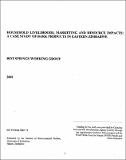| dc.contributor.author | Mukamuri, B.B. | |
| dc.contributor.author | Kozanayi, W. | |
| dc.coverage.spatial | Zimbabwe | en_GB |
| dc.date.accessioned | 2014-10-16T12:22:56Z | |
| dc.date.available | 2014-10-16T12:22:56Z | |
| dc.date.issued | 2001 | |
| dc.identifier.citation | Mukamuri, B.B. (2000) 'Commercialization and Institutional Arrangements Involving Tree Species Harvested for Bark by small-holder farmers in Zimbabwe', In: Household Livelihoods, Marketing And Resource Impacts: A Case Study Of Bark Products In Eastern Zimbabwe, IES Working Paper No. 18. Harare, Mt. Pleasant : IES. | en_GB |
| dc.identifier.uri | https://opendocs.ids.ac.uk/opendocs/handle/20.500.12413/4803 | |
| dc.description | IES Working Paper. | en_GB |
| dc.description.abstract | Non-timber forest products are increasingly being commercialized by smallholder farmers and urban-based healers and vendors. In this paper we highlight institutional arrangements surrounding the harvesting and marketing of three tree species harvested for their bark: Adansonia digitata, Warburgia salutaris and Berchemia discolor. Bark from Berchemia discolor and Adansonia digitata is used for craft production. Bark from Warburgia salutaris is believed by many healers to treat a panacea of ailments and the tree is threatened with extinction in Zimbabwe. Increase in commercialization is linked to droughts, tourism, hard economic conditions prevailing in the country and poor access to formal health services. Some studies have also linked over-exploitation and commercialization to weakening state and traditional institutions. The studies therefore sought to investigate institutional arrangements and sustainability issues related to the three tree species in Zimbabwe. Local institutions were not effective in the sustainable management of the resources. There was little evidence of new institutional arrangements emerging around these particular resources, as a result of the changes in degree of commercialization. The bark resources were still largely communally owned and. there was no evidence of increasing domestication, except in the case of Warburgia, where there was a project promoting tree planting. Despite increasing commercialization and demand for these products there are few examples of sustainable harvesting. The evidence is that commercialization cannot be used to drive conservation agendas. | en_GB |
| dc.description.sponsorship | Funding for the study was provided by Canadian International Development Agency (CIDA) through the Agroforestry Southern Africa project and the World Wide Fund for Nature (WWF) People and Plants Initiative. | en_GB |
| dc.language.iso | en | en_GB |
| dc.publisher | Institute of Environmental Studies (IES) ; University of Zimbabwe. | en_GB |
| dc.relation.ispartofseries | IES Working Paper Series.;Paper No. 18. | |
| dc.rights.uri | http://creativecommons.org/licenses/by-nc-nd/3.0/ | en_GB |
| dc.subject | Environment | en_GB |
| dc.subject | Trade | en_GB |
| dc.title | Commercialization and Institutional Arrangements Involving Tree Species Harvested for Bark by small-holder farmers in Zimbabwe | en_GB |
| dc.title.alternative | Household Livelihoods, Marketing And Resource Impacts: A Case Study Of Bark Products In Eastern Zimbabwe | en_GB |
| dc.type | Series paper (non-IDS) | en_GB |
| dc.rights.holder | University of Zimbabwe | en_GB |


